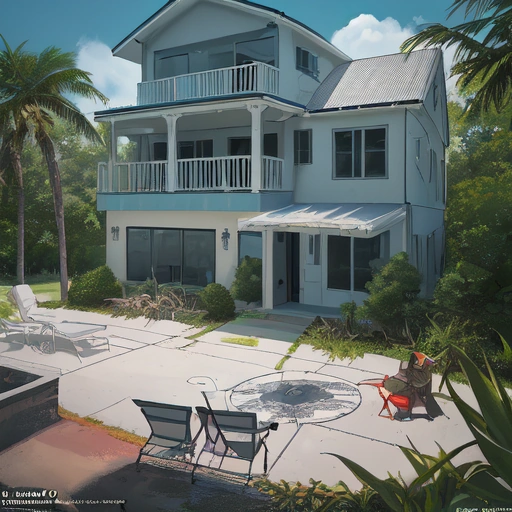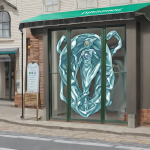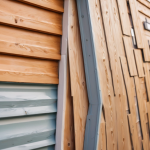Florida Homeowner’s Guide 2024: Vinyl vs. Fiber Cement Siding – Choosing the Best Protection Against Heat, Humidity, and Hurricanes
Florida’s Siding Showdown: Vinyl vs. Fiber Cement
Florida living: sunshine, beaches, and… relentless weather. Heat, humidity, and the ever-present threat of hurricanes demand building materials that can withstand the elements. For homeowners, choosing the right siding is a critical decision, impacting not only curb appeal but also long-term protection and property value. Two popular contenders consistently emerge: vinyl siding and fiber cement siding. But which reigns supreme in the Sunshine State? This guide dives deep into the pros and cons of each, providing a comprehensive analysis to help you make an informed choice for your Florida home.
We will focus on the performance of these materials in the decade between 2010 and 2019, providing a historical context for their current standing. Selecting the right siding for Florida homes is more than just an aesthetic choice; it’s a critical investment in safeguarding your property against the unique challenges posed by Florida weather. The intense sun can cause fading and warping, while the high humidity fosters mold and mildew growth. Coastal homes face the added threat of saltwater corrosion and powerful hurricane-force winds.
Therefore, understanding the long-term performance and durability of different siding materials is paramount for any Florida homeowner looking to maximize their home improvement investment and ensure adequate hurricane protection. This comprehensive guide specifically addresses the key considerations for Florida homeowners when selecting between vinyl siding and fiber cement siding. We will analyze siding cost, installation requirements, maintenance needs, and, most importantly, resistance to the elements. We will delve into the specific attributes that make each material suitable—or unsuitable—for different regions within Florida, from the relatively calmer inland areas to the exposed coastal communities. By examining real-world performance data and expert opinions, this guide aims to equip you with the knowledge necessary to make an informed decision that balances cost-effectiveness with long-term protection and peace of mind. James Hardie siding, a leading brand in fiber cement, will be considered, alongside other options, to provide a complete overview.
Vinyl Siding: The Budget-Friendly Option – But at What Cost?
Vinyl siding, a petroleum-based product, has long been a budget-friendly option for homeowners nationwide. In Florida, its appeal lies in its relatively low upfront cost and ease of installation, making it an attractive choice for those looking to quickly update their Florida homes. However, its performance in extreme heat and hurricane-force winds requires careful consideration, especially for coastal homes that experience the full brunt of Florida weather. Understanding the limitations of vinyl siding is crucial for making an informed decision about hurricane protection and long-term home improvement investments.
While it may seem like a simple solution, the potential for damage and subsequent repairs can offset the initial savings. **Pros of Vinyl Siding in Florida:** Cost-Effective: Vinyl generally has a lower initial siding cost compared to fiber cement siding, making it an accessible option for budget-conscious homeowners. Easy Installation: Lighter weight and simpler installation can translate to lower labor costs, further reducing the overall project expense. Moisture Resistance: Vinyl is inherently waterproof, resisting rot and mold growth, which is particularly beneficial in Florida’s humid climate.
Low Maintenance: Requires minimal upkeep, typically just washing with soap and water, saving homeowners time and money on maintenance. **Cons of Vinyl Siding in Florida:** Heat Sensitivity: Can warp, crack, or fade in intense sunlight and heat. Darker colors are particularly vulnerable, potentially diminishing the aesthetic appeal and requiring premature replacement. Wind Resistance: Standard vinyl siding may not withstand hurricane-force winds, leading to damage and potential water intrusion, compromising the home’s structural integrity. Look for impact-resistant vinyl siding, but expect a higher price point that may negate the initial cost savings.
Aesthetics: While vinyl siding has improved over the years, it may not replicate the look of natural wood as convincingly as fiber cement siding, potentially impacting property value in certain neighborhoods. Pest Resistance: While resistant to rot, vinyl itself isn’t a food source for pests. However, gaps behind the siding can provide harborage for insects and rodents, potentially leading to infestations. Furthermore, the long-term value proposition of vinyl siding in Florida needs careful evaluation. While the initial siding cost is lower, the potential for damage from hurricanes and the degrading effects of constant sun exposure can lead to more frequent repairs and replacements compared to more durable options like fiber cement.
This makes understanding the true lifecycle cost a critical factor for homeowners considering vinyl siding for their Florida homes. Investing in enhanced installation techniques, such as using thicker gauge vinyl and ensuring proper fastening, can improve wind resistance but also increases the overall expense. Ultimately, the decision to use vinyl siding in Florida should involve a thorough assessment of the home’s location, exposure to the elements, and the homeowner’s long-term financial goals. While it can be a viable option for some, particularly in sheltered areas away from the coast, homeowners in hurricane-prone regions should carefully weigh the benefits against the risks. Consulting with experienced contractors who understand the nuances of Florida weather and building codes is essential to making an informed choice that balances siding durability, aesthetics, and cost.
Fiber Cement Siding: The Premium Choice for Hurricane-Prone Regions
Fiber cement siding presents a formidable defense against Florida’s challenging climate, emerging as a premium alternative for homeowners prioritizing long-term resilience. Composed of cement, sand, and cellulose fibers, this siding option offers superior protection compared to vinyl siding, particularly in hurricane-prone regions. James Hardie siding, a recognized leader in the fiber cement market, exemplifies the material’s potential, renowned for its exceptional durability and aesthetic versatility. While the initial siding cost is undeniably higher than vinyl siding, the long-term value derived from fiber cement’s resistance to Florida weather and potential for increased property value makes it a compelling investment for discerning homeowners.
One of the most significant advantages of fiber cement siding for Florida homes is its exceptional durability. Unlike vinyl siding, which can warp, crack, or melt under intense heat, fiber cement maintains its structural integrity even under the relentless Florida sun. Its robust composition also provides superior impact resistance, crucial for withstanding wind-borne debris during hurricanes. According to the Insurance Institute for Business & Home Safety (IBHS), homes with fiber cement siding often experience less damage from severe weather events compared to those with less durable materials.
This enhanced protection translates to lower repair costs and reduced insurance premiums over the lifespan of the siding. However, the benefits of fiber cement extend beyond mere durability; its inherent properties also contribute to a healthier and safer living environment. Fiber cement is naturally resistant to moisture, preventing the growth of mold and mildew, common concerns in Florida’s humid climate. Furthermore, it is impervious to termites and other wood-boring insects, eliminating the need for costly pest control treatments.
Perhaps most importantly, fiber cement is non-combustible, providing a critical layer of fire protection for Florida homes. This fire resistance can be a significant selling point, particularly in areas prone to wildfires or where building codes mandate fire-resistant materials. Despite its numerous advantages, it’s crucial to acknowledge the cons of fiber cement siding. The higher siding cost is a primary consideration, and the complex installation process necessitates skilled professionals, further increasing the overall investment. Regular maintenance, including painting every 5-10 years, is also required to preserve its aesthetic appeal and protective qualities. Moreover, the weight of fiber cement can pose logistical challenges during installation. For homeowners prioritizing hurricane protection and long-term value, the investment in fiber cement siding is often justified. However, a thorough cost-benefit analysis, considering both upfront expenses and long-term savings, is essential before making a final decision regarding home improvement choices for Florida homes.
Making the Right Choice: Factors to Consider
Choosing between vinyl and fiber cement siding requires a careful assessment of your budget, priorities, and the specific demands of your location. Impact-resistant vinyl siding can mitigate some of the wind resistance concerns, but it comes at a higher price. Fiber cement offers superior durability and aesthetic appeal but demands a larger upfront investment. **Expert Opinions:** “In coastal areas, fiber cement is the clear winner. The added protection against wind-borne debris and saltwater intrusion is worth the investment,” says John Miller, a licensed contractor in Miami-Dade County.
“For inland homes with budget constraints, a good quality, thicker gauge vinyl siding can be a viable option, especially if properly installed and maintained,” notes Sarah Chen, a siding specialist in Orlando.
**Common Homeowner Concerns:** Will vinyl siding increase my insurance rates? Standard vinyl siding may not qualify for certain wind mitigation credits, potentially impacting your insurance premiums. Check with your insurance provider. How long will each type of siding last? Vinyl siding typically lasts 20-40 years, while fiber cement can last 50 years or more with proper maintenance. What are the long-term maintenance costs? While vinyl requires minimal maintenance, the cost of repainting fiber cement every 5-10 years should be factored into your budget.
**Comparison Table:** | Feature | Vinyl Siding | Fiber Cement Siding |
| —————- | —————————————— | —————————————— |
| Initial Cost | Lower | Higher |
| Installation Cost | Lower | Higher |
| Durability | Moderate (Impact-resistant options available) | High |
| Maintenance | Low | Moderate (Requires painting) |
| Aesthetics | Good | Excellent |
| Wind Resistance | Moderate (Impact-resistant options available) | High |
| Moisture Resistance | Excellent | Excellent |
| Pest Resistance | Good (Susceptible to harborage) | Excellent |
| Fire Resistance | Poor | Excellent |
Beyond the initial siding cost, Florida homeowners should also consider the long-term implications of their choice. For coastal homes constantly battered by saltwater and high winds, the enhanced siding durability of fiber cement, especially James Hardie siding, can prevent costly repairs down the line. While the price tag may seem daunting initially, the ability of fiber cement siding to withstand Florida weather and provide superior hurricane protection often translates to significant savings over the lifespan of the siding.
These savings come not only from reduced repair costs but also potentially from lower insurance premiums, as more robust siding options often qualify for wind mitigation credits. Another crucial factor is the aesthetic value and its impact on Florida real estate. While vinyl siding has improved significantly in appearance over the years, fiber cement offers a wider range of styles and textures, mimicking the look of natural wood without the associated maintenance. This aesthetic versatility allows homeowners to enhance their curb appeal and potentially increase their property value.
Furthermore, fiber cement’s ability to be painted in a variety of colors provides greater customization options to match the unique architectural style of Florida homes. This is a significant advantage over vinyl siding, which can be more limited in color choices and may fade over time. Finally, consider the environmental impact of your siding choice. While vinyl siding is a petroleum-based product, fiber cement is composed of more sustainable materials like cement, sand, and cellulose fibers.
Although the manufacturing process for fiber cement can be energy-intensive, its longer lifespan and reduced need for replacement can offset some of these environmental concerns. Home improvement decisions should not only focus on immediate cost savings but also on the long-term sustainability and resilience of the materials used, especially in a climate as demanding as Florida’s. Making an informed decision requires weighing all these factors to ensure the best protection and value for your home.
Protecting Your Investment: A Final Verdict
Ultimately, the optimal siding choice for Florida homes hinges on a homeowner’s unique circumstances, balancing upfront siding cost with long-term resilience against Florida weather. While vinyl siding presents an attractive entry point due to its affordability, particularly for inland properties less exposed to extreme coastal conditions, fiber cement siding offers a superior level of hurricane protection and longevity, especially crucial for coastal homes. Consider not only your budget but also your aesthetic preferences and long-term maintenance goals.
As Bob Vila, the renowned home improvement expert, notes, ‘Investing in quality siding is investing in the structural integrity and long-term value of your home, particularly in regions prone to severe weather.’ Making an informed decision requires gathering comprehensive data. Obtain multiple quotes from licensed contractors experienced in both vinyl siding and fiber cement siding installation, specifically for Florida homes. These quotes should detail not only the material costs but also labor, potential demolition of existing siding, and any necessary structural repairs.
According to a 2023 report by the National Association of Home Builders, the average siding cost for fiber cement is approximately 2 to 3 times higher than vinyl, but this premium often translates into lower long-term maintenance expenses and enhanced protection against hurricane-force winds, a critical factor for hurricane protection. Furthermore, inquire about manufacturer warranties and independent lab testing data regarding impact resistance and wind load ratings. Prioritize proper installation, irrespective of the chosen material, to ensure optimal performance and prevent costly problems down the road.
Improperly installed vinyl siding can be susceptible to wind damage, while incorrect fiber cement installation can lead to moisture intrusion and premature failure. James Hardie siding, a leading brand in the fiber cement market, offers specific installation guidelines that must be strictly followed to maintain warranty coverage. Remember that local building codes may also dictate specific requirements for siding installation in high-wind zones. The information presented reflects the general performance of these materials; consult current building codes and product specifications for the most up-to-date information. By carefully weighing the pros and cons, consulting with qualified professionals, and adhering to best practices, you can select siding that not only enhances the beauty of your Florida home but also provides lasting protection against the elements.


